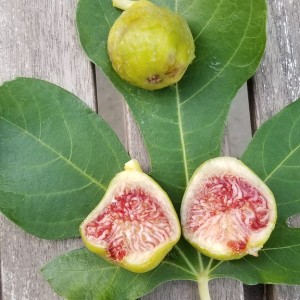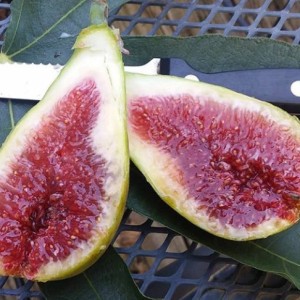This site contains affiliate links for which I may be compensated.
San Pietro
San Pietro Information


-
Possible Synonyms / AKA:
DFIC 79, Dalmatie, Stella
-
Introduced By:
-
Origin:
Italy -
Main Flavor Group:
-
Family Group:
-
Fig Type:
Common - Self fertile and will grow anywhere conditions are suitable -
Cold Hardy:
N/A -
Container Variety:
Yes -
Easy Rooting:
N/A -
Main Season:
any -
Availability:
N/A -
Breba Crop:
Yes -
Seed Crunch:
N/A -
Eye:
N/A -
Skin Toughness:
N/A -
Fruit Size:
N/A -
Rain Resistance:
N/A -
Tree Vigor:
-
External Links:
http://figs4funforum.arghchive.com/post/ucd-san-pietro-fig-pics-5945644
http://figs4funforum.arghchive.com/post/san-pietroa-minuscule-old-fig-with-large-fruits-2958331
Description

Not to be mistaken by JM ">San Pietro from Joe Morle.
Ray Givens:
A large light colored fig from the Dalmatian coast of what is now Croatia. Leaf: cordate, variable shape from 3-lobed with shallow sinuses and broad lobes to 5-lobed with deep sinuses and long, narrow lobes, lobes commonly Auricled , very shallowly crenate margins. Brebas: light-green, oblique-pyriform with prominent neck, medium eye, dark strawberry pulp. Sweet and rich. Main crop : large, turbinate mostly without neck, yellowish-green, above medium, open eye, light pink pulp. Fairly rich flavor. Condit recommends it only for coastal California. I got two plants from cuttings Don Polensky sent me in January 1998. Now I can trial it here. No synonyms.
Condit Monograph
San Pietro: Described by Trabut (1904), Blin (1942), Societe' Pomologique DE France (1947), and Condit (1947). Illustrated in color by Condit (1941a). In 1901, the United States Department of Agriculture introduced a variety of fig under P.I. No. 5,919 and the name San Pietro. It came from Lesina (Hvar) Island, Dalmatia, and was reported to be an early-season fig of exceptionally large size. Trees at Chico, California, when seen in August, 1916, were producing medium-sized figs, green in color, with amber pulp. In 1926, cuttings of San Pietro were obtained from the late Leroy Nickel, of Menlo Park. These were grown first at Fresno, and since 1932, in the collection of varieties at Riverside. It was such a satisfactory variety at Menlo Park that ''it almost stopped the quest for a better fig'' (according to the gardener, Theodore Woolley), producing two crops of excellent figs, both under glass and out of doors. The account by Trabut, and especially that of the Societe' Pomologique DE France, leave little doubt that the San Pietro described by them is the same as the one now under trial in California, which is treated herewith. However, if the variety does have merit, as the second account states, it seems strange that other French and Italian horticulturists have not included it in their publications.
The tree at Riverside is only moderately vigorous; terminal buds are green to dingy brown. Leaves medium, glossy above, variable, some 3-lobed with shallow sinuses and broad lobes, others 5-lobed with deep sinuses and long, narrow lobes, both upper and basal lobes commonly Auricled ; base cordate; margins very shallowly crenate. (Plate 13.)
Breba crop fair; figs large, up to 2 inches in diameter and 2-3/4 inches in length, oblique-pyriform, with prominent neck; stalk short; eye medium, open; white flecks large, scattered; surface dull; ribs few, only slightly elevated; color light green; meat thin, tinged with violet; pulp dark strawberry; flavor rich, sweet; quality good.
Second-crop figs large, up to 2-1/4 inches broad and 3 inches long, turbinate, mostly without neck, or neck present and gradually narrowed from body to stalk; average weight 73 grams; stalk short; ribs branched, slightly elevated; apex broad, flattened; eye above medium, open, scales chaffy or pink, with scarious margins; white flecks few, large, widely spaced; color yellowish green; pulp light strawberry, hollow; flavor fairly rich. Quality mediocre; dried color poor.
Caprified specimens have dark-strawberry, solid pulp, with large seeds; average weight 88 grams. Recommended for trial in coastal sections of California only. (Plate 25, A.)
The tree at Riverside is only moderately vigorous; terminal buds are green to dingy brown. Leaves medium, glossy above, variable, some 3-lobed with shallow sinuses and broad lobes, others 5-lobed with deep sinuses and long, narrow lobes, both upper and basal lobes commonly Auricled ; base cordate; margins very shallowly crenate. (Plate 13.)
Breba crop fair; figs large, up to 2 inches in diameter and 2-3/4 inches in length, oblique-pyriform, with prominent neck; stalk short; eye medium, open; white flecks large, scattered; surface dull; ribs few, only slightly elevated; color light green; meat thin, tinged with violet; pulp dark strawberry; flavor rich, sweet; quality good.
Second-crop figs large, up to 2-1/4 inches broad and 3 inches long, turbinate, mostly without neck, or neck present and gradually narrowed from body to stalk; average weight 73 grams; stalk short; ribs branched, slightly elevated; apex broad, flattened; eye above medium, open, scales chaffy or pink, with scarious margins; white flecks few, large, widely spaced; color yellowish green; pulp light strawberry, hollow; flavor fairly rich. Quality mediocre; dried color poor.
Caprified specimens have dark-strawberry, solid pulp, with large seeds; average weight 88 grams. Recommended for trial in coastal sections of California only. (Plate 25, A.)
If you'd like your banner to be shown here and throughout Fig Database, send us a message.
Photos Add Your Image
No Images Found
YouTube Videos
No Videos Found








